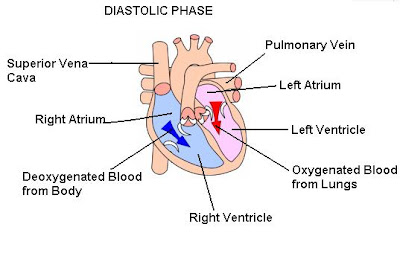The cardiac cycle begins with a period of fast ventricular filling. The right atrium fills with deoxygenated blood from the superior vena cava, the inferior vena cava, and the coronary venous return. At the same time, the pulmonary veins return oxygenated blood from the lungs to the left atrium. During the early diastolic phase of the cardiac cycle, both ventricles relax and fill from their respective atrial sources. The atrio-ventricular valves (the tricuspid valve and the mitral valve) open and allow blood to flow from the atria into the ventricles.
During the systolic phase, the ventricles contracts to pump the blood out into the arteries. The right ventricle pumps the deoxygenated blood (carbondioxide-containing blood) out into the pulmonary artery, which takes the blood to the lungs to release the carbondioxide and pick up oxygen. The left ventricle pumps the oxygenated blood out into the aortic artery, which distributes the oxygen-rich blood throughout the body.


No comments:
Post a Comment